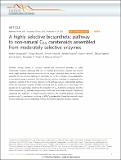A highly selective biosynthetic pathway to non-natural C[subscript 50] carotenoids assembled from moderately selective enzymes
Author(s)
Furubayashi, Maiko; Ikezumi, Mayu; Takaichi, Shinichi; Maoka, Takashi; Hemmi, Hisashi; Ogawa, Takuya; Saito, Kyoichi; Tobias, Alexander V; Umeno, Daisuke; ... Show more Show less
DownloadFurubayashi-2015-Highly selective.pdf (1008.Kb)
PUBLISHER_CC
Publisher with Creative Commons License
Creative Commons Attribution
Terms of use
Metadata
Show full item recordAbstract
Synthetic biology aspires to construct natural and non-natural pathways to useful compounds. However, pathways that rely on multiple promiscuous enzymes may branch, which might preclude selective production of the target compound. Here, we describe the assembly of a six-enzyme pathway in Escherichia coli for the synthesis of C[subscript 50]-astaxanthin, a non-natural purple carotenoid. We show that by judicious matching of engineered size-selectivity variants of the first two enzymes in the pathway, farnesyl diphosphate synthase (FDS) and carotenoid synthase (CrtM), branching and the production of non-target compounds can be suppressed, enriching the proportion of C[subscript 50] backbones produced. We then further extend the C[subscript 50] pathway using evolved or wild-type downstream enzymes. Despite not containing any substrate- or product-specific enzymes, the resulting pathway detectably produces only C[subscript 50] carotenoids, including ~90% C[subscript 50]-astaxanthin. Using this approach, highly selective pathways can be engineered without developing absolutely specific enzymes.
Date issued
2015-07Department
Massachusetts Institute of Technology. Department of Biological EngineeringJournal
Nature Communications
Publisher
Nature Publishing Group
Citation
Furubayashi, Maiko, Mayu Ikezumi, Shinichi Takaichi, Takashi Maoka, Hisashi Hemmi, Takuya Ogawa, Kyoichi Saito, Alexander V Tobias, and Daisuke Umeno. “A Highly Selective Biosynthetic Pathway to Non-Natural C[subscript 50] Carotenoids Assembled from Moderately Selective Enzymes.” Nature Communications 6 (July 14, 2015): 7534. © 2015 Macmillan Publishers Limited
Version: Final published version
ISSN
2041-1723